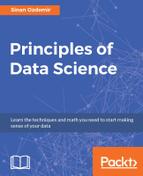The topic of this book is data science, which is a field of study and application that has been growing rapidly for the past several decades. As a growing field, it is gaining a lot of attention in both the media as well as in the job market. The United States recently appointed its first ever chief data scientist, DJ Patil. This move was modeled after tech companies who, honestly, only recently started hiring massive data teams. These skills are in high demand and their applications extend much further than today's job market.
This book will attempt to bridge the gap between math/programming/domain expertise. Most people today have expertise in at least one of these (maybe two), but proper data science requires a little bit of all three. We will dive into topics from all three areas and solve complex problems. We will clean, explore, and analyze data in order to derive scientific and accurate conclusions. Machine learning and deep learning techniques will be applied to solve complex data tasks.
Chapter 1, How to Sound Like a Data Scientist, gives an introduction to the basic terminology used by data scientists and a look at the types of problem we will be solving throughout this book.
Chapter 2, Types of Data, looks at the different levels and types of data out there and how to manipulate each type. This chapter will begin to deal with the mathematics needed for data science.
Chapter 3, The Five Steps of Data Science, uncovers the five basic steps of performing data science, including data manipulation and cleaning, and sees examples of each step in detail.
Chapter 4, Basic Mathematics, helps us discover the basic mathematical principles that guide the actions of data scientists by seeing and solving examples in calculus, linear algebra, and more.
Chapter 5, Impossible or Improbable – a Gentle Introduction to Probability, is a beginner's look into probability theory and how it is used to gain an understanding of our random universe.
Chapter 6, Advanced Probability, uses principles from the previous chapter and introduces and applies theorems, such as the Bayes Theorem, in the hope of uncovering the hidden meaning in our world.
Chapter 7, Basic Statistics, deals with the types of problem that statistical inference attempts to explain, using the basics of experimentation, normalization, and random sampling.
Chapter 8, Advanced Statistics, uses hypothesis testing and confidence interval in order to gain insight from our experiments. Being able to pick which test is appropriate and how to interpret p-values and other results is very important as well.
Chapter 9, Communicating Data, explains how correlation and causation affect our interpretation of data. We will also be using visualizations in order to share our results with the world.
Chapter 10, How to Tell If Your Toaster Is Learning – Machine Learning Essentials, focuses on the definition of machine learning and looks at real-life examples of how and when machine learning is applied. A basic understanding of the relevance of model evaluation is introduced.
Chapter 11, Predictions Don't Grow on Trees, or Do They?, looks at more complicated machine learning models, such as decision trees and Bayesian-based predictions, in order to solve more complex data-related tasks.
Chapter 12, Beyond the Essentials, introduces some of the mysterious forces guiding data sciences, including bias and variance. Neural networks are introduced as a modern deep learning technique.
Chapter 13, Case Studies, uses an array of case studies in order to solidify the ideas of data science. We will be following the entire data science workflow from start to finish multiple times for different examples, including stock price prediction and handwriting detection.
